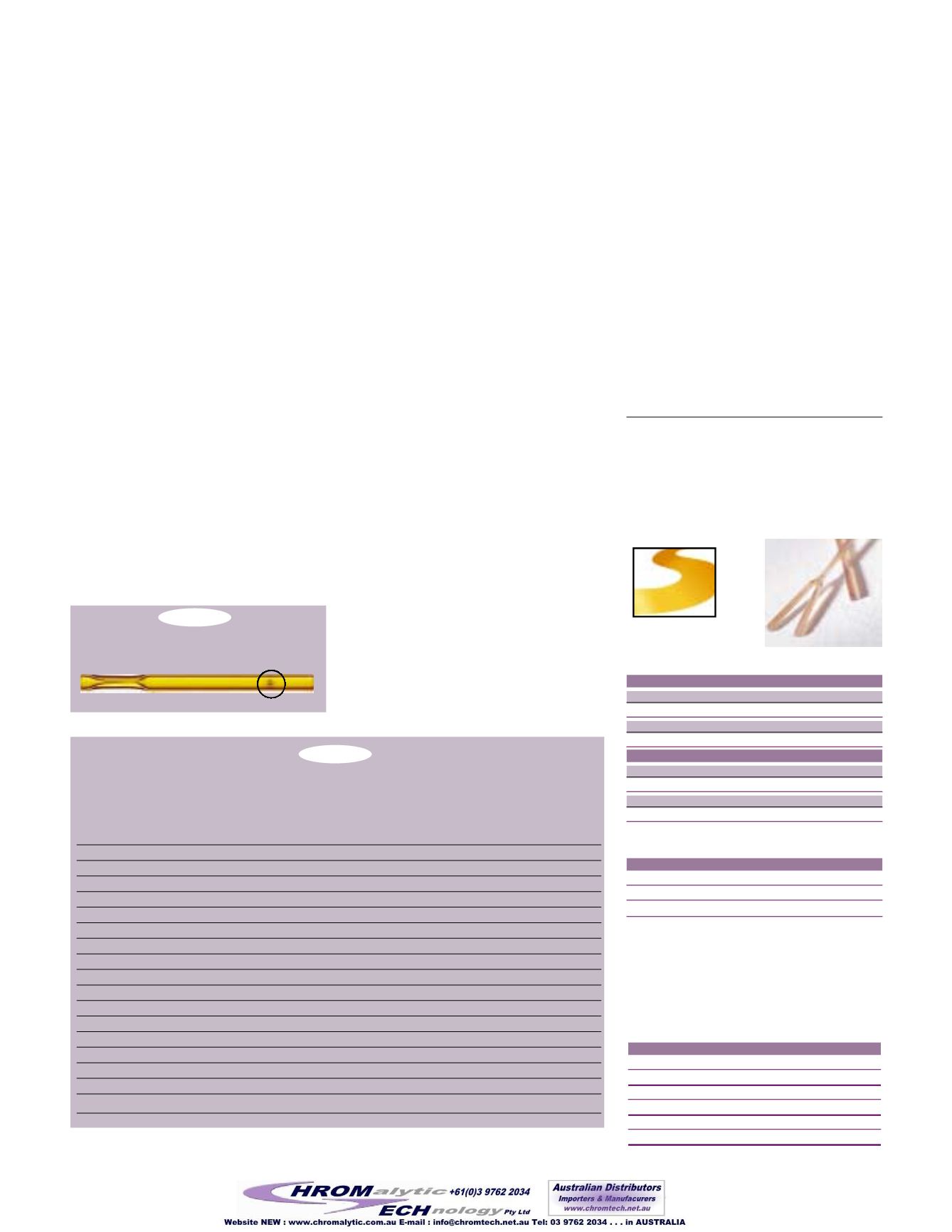

• 10 •
www.restekcorp.com800-356-1688
by Gary Stidsen, Innovations Manager, and David Smith, Ph.D., R&D Senior Chemist
Improved GC Analysis of
Semivolatile Compounds
Using a Siltek
™
Drilled Uniliner
®
Inlet
Liner & Rtx
®
-5Sil MS Column
✔
Sensitive enough for on-column concentrations down to 4ng.
✔
Siltek
™
deactivation ensures reproducibility.
✔
Fast analysis for US EPA Method 8270.
✔
For Agilent GCs.
A new era in inlet liner inertness was realized with
the development of Siltek
™
passivation. The inert
surface of Siltek
™
inlet liners has been shown to
reduce the loss of basic and acidic compounds.
1,2
To further investigate the benefits of Siltek
™
deacti-
vation, semivolatile compounds listed in EPA
Method 8270 were analyzed to test for response
and linearity.
The chromatographic system used for these liner
evaluations included an Agilent 6890 GC with a
5973 MS detector. Restek engineers have designed a
unique drilledUniliner
®
liner that can be used in the
split/splitless injection ports of 5890 and 6890 GCs
(Figure 1). A small hole drilled into the upper part
of the liner results in sample discrimination charac-
teristics of direct injection in combination with the
splitless injection technique. This equalizes the pres-
sure between the upstream and split vent pressure
sensors and eliminates pressure malfunctions. These
liners also reduce injection port discrimination and
prevent the injected sample from contacting metal
injection port parts. This is accomplished by sealing
the column into the press-tight taper in the
Uniliner
®
liner. The compounds are then completely
contained in the deactivated liner. Another important
characteristic in obtaining optimum inertness is
proper inlet liner deactivation. Siltek
™
drilled
Uniliner
®
inlet liners were used to analyze the com-
plete Method 8270 list at five on-column concentra-
tion levels: 4, 10, 16, 24, and 32ng per component.
Table I
Active compounds from the Method 8270 list were evaluated for relative response and linearity
(4, 10, 16, 24, 32ng on-column) using the Rtx
®
-5Sil MS with the Agilent 6890 GC/5973 MS.
A subset of active compounds from the EPA Method
8270 compound list was used to determine the
effectiveness of these liners. This list contains the
most active compounds, which were evaluated for
response factors and linearity over the five different
concentrations. The compounds are listed in Table
I with response factors and linearity results.
At 4ng on-column concentration per component,
the Siltek
™
liners show a high response with low
standard deviation for these active Method 8270
compounds. Furthermore, the liners show excel-
lent linearity over the calibration curve. Figure 2
illustrates a sample chromatogram of 24ng per
component with an analysis time of less than 22
minutes. As this analytical system shows, the inert-
ness of Siltek
™
deactivation in combination with the
fast analysis time using optimized run conditions
has the capability of improving sample output in the
laboratory. For more detailed information, request
Application Note #59125.
1
Restek Applications Note #59111
Minimizing Breakdown of
Chlorinated Pesticides Using Siltek
™
-Deactivated GC
Accessories.
2
Restek Applications Note #59113
Siltek
™
-Deactivation Delivers
Inertness to Analyte Breakdown and Reactivity, and Durability
to Physical and Chemical Challenges.
Figure 1
The drilled hole makes direct injection
possible with EPC systems.
4ppm 10ppm 16ppm 24ppm 32ppm
ISTD QIon
RRF
RRF
RRF
RRF
RRF ave RRF %RSD
N-nitrosodimethylamine
1
74
0.700
0.682
0.684
0.691
0.682
0.686
1%
pyridine
1
79
0.594
0.738
0.701
0.916
0.823
0.711
16%
aniline
1
93
2.197
2.148
2.080
2.051
2.031
2.067
3%
N-nitroso-di-
n
-propylamine
1
70
0.635
0.684
0.617
0.654
0.599
0.609
5%
benzoic acid
2
122
0.291
0.185
0.196
0.221
0.215
0.209
19%
2,4-dichlorophenol
2
162
0.250
0.252
0.248
0.240
0.240
0.241
2%
2,4-dinitrophenol
3
184
0.105
0.152
0.160
0.172
0.163
0.155
17%
3-nitroanaline
3
138
0.322
0.359
0.358
0.363
0.342
0.347
5%
4-nitrophenol
3
109
0.157
0.186
0.190
0.183
0.175
0.177
7%
acenaphthene
3
152
1.200
1.160
1.130
1.030
1.010
1.110
8%
hexachlorocyclopentadiene
3
237
0.263
0.297
0.293
0.288
0.290
0.282
5%
azobenzene
3
77
1.358
1.460
1.396
1.296
1.246
1.296
6%
pentachlorophenol
4
266
0.169
0.189
0.191
0.183
0.172
0.181
5%
nitrosodiphenylamine
4
169
0.781
0.786
0.742
0.705
0.640
0.704
8%
benzidine
5
184
0.418
0.548
0.504
0.623
0.539
0.538
14%
benzo(b)fluoranthene
6
252
1.251
1.381
1.333
1.324
1.295
1.358
4%
benzo(g,h,i)perylene
6
276
1.347
1.472
1.441
1.427
1.372
1.446
4%
Siltek
™
Guard Columns
ID
5-Meter (ea.)
10-Meter (ea.)
0.25mm
10026
10036
0.32mm
10027
10037
0.53mm
10028
10038
Siltek
™
—by Restek
Siltek
™
Press-Tight
®
Connectors
5-pk.
25-pk.
100-pk.
straight
20480
20449
20481
angled
20482
20483
20484
ea.
3-pk.
“Y”
20485
20486
Angled “Y”
20487
20469
Integra-Guard
™
Columns
Guard columns without press-tight connections—
protecting your analytical column has never been
this easy! Simply add the appropriate suffix number
and price to the analytical column’s catalog number
and price.
ID
length
suffix #
0.25mm
5m
-124
10m
-127
0.28mm
5m
-243
10m
-244
0.32mm
5m
-125
10m
-128


















